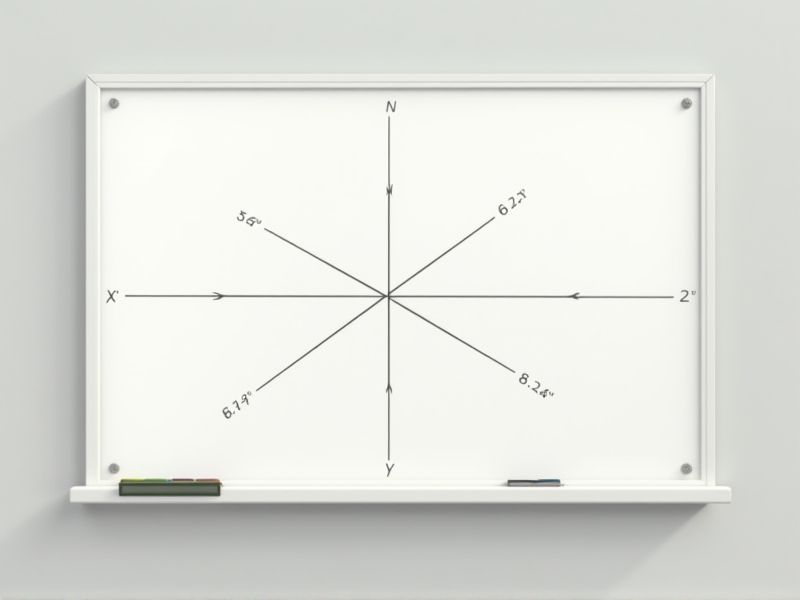
Classroom whiteboards typically come in standard dimensions to ensure they fit most educational settings and meet teachers' needs. The most common sizes are 4 feet by 6 feet (48 inches by 72 inches) and 4 feet by 8 feet (48 inches by 96 inches), providing ample space for writing and demonstrations. Smaller boards, such as 3 feet by 4 feet, are also available for more compact classrooms or specific activities. When selecting a whiteboard, consider both the classroom size and the number of students to ensure everyone can see the board clearly during lessons.
Width In Inches
Classroom whiteboards typically measure between 48 to 72 inches in width, providing ample space for teacher demonstrations and student engagement. A 60-inch whiteboard is often considered the ideal size for a standard classroom, accommodating a balance between visibility and space efficiency. When selecting a whiteboard, consider that a width of 48 inches suits smaller classrooms, while a width of 72 inches benefits larger group settings. Your choice of width can significantly impact classroom interaction, so choose wisely based on the size of your class and teaching style.
Height In Inches
The ideal height for classroom whiteboards typically ranges from 36 to 42 inches from the floor, accommodating various student and teacher needs. This height ensures that writing remains accessible for most users, allowing easy visibility while standing or sitting. For effective learning, the whiteboard should cover a width of at least 4 to 6 feet, providing ample space for lessons and collaborative activities. When considering installation, make sure to account for adjustable furniture, as this can impact optimal height positioning for diverse classroom settings.
Surface Material
The surface material of classroom whiteboards is crucial for optimal writing and erasing performance. High-quality whiteboards typically utilize a porcelain enamel or melamine surface, which offers superior durability and resistance to stains, ensuring a lifespan of 10-20 years. You can enhance your classroom experience by selecting boards with low-glare finishes, as these reduce eye strain during lessons, allowing for clearer visibility. Regular maintenance, including the use of appropriate cleaning solutions, prolongs the surface integrity and functionality of your whiteboard.
Frame Material
Classroom whiteboards are commonly constructed from materials such as porcelain, glass, or melamine, each offering distinct advantages. Porcelain, typically known for its durability, is resistant to scratching and staining, making it ideal for high-use environments with an average lifespan of over 20 years. In contrast, glass whiteboards provide a sleek, modern appearance and an easy-to-clean surface, often featuring a smooth writing experience. Melamine boards, while more budget-friendly, tend to have a shorter lifespan of 5 to 7 years and may exhibit ghosting over time; thus, understanding these differences can help you choose the right whiteboard for your classroom needs.
Mounting Method
Mounting methods for classroom whiteboards vary, with popular options including wall-mounted, mobile, and interactive models. Wall-mounted whiteboards typically require strong anchors and support for stability, accommodating sizes ranging from 4x6 feet to 4x12 feet. Mobile whiteboards on wheels provide flexibility in classroom arrangement, often featuring dual-side surfaces and additional storage. Interactive whiteboards, offering touchscreen technology for enhanced engagement, require specialized mounting systems and access to power sources.
Aspect Ratio
The standard aspect ratio for classroom whiteboards is typically 16:9, which complements modern teaching tools like projectors and interactive displays. This widescreen format provides ample space for visual aids while facilitating collaborative activities among students. Most educational institutions prefer sizes that range from 3 to 5 feet in height and 6 to 12 feet in width, ensuring visibility for all students. Choosing the right aspect ratio enhances the overall learning experience by maximizing space and improving visibility during lessons.
Writable Area
The writable area of a standard classroom whiteboard typically measures around 4 feet by 8 feet, providing ample space for teaching and collaborative activities. This non-porous surface is designed for easy erasing and is compatible with various markers, ensuring clarity during presentations. Many models are designed with magnetic properties, allowing you to attach educational materials or visual aids directly to the board, enhancing classroom interaction. With proper maintenance, these boards can last for several years, making them a durable investment for educational settings.
Weight Capacity
Classroom whiteboards typically have a weight capacity ranging from 20 to 40 pounds, depending on the material and mounting type. If you're considering a whiteboard for your classroom, look for those made of high-quality materials such as melamine, porcelain, or glass, which can offer greater durability and a longer lifespan. Proper installation is crucial; wall mounting should ideally involve anchors capable of holding substantial weight to prevent sagging or detachment. Regular maintenance, including cleaning and checking for secure mounts, can significantly extend the functional capacity and safety of your whiteboard.
Erasability Quality
Classroom whiteboards prioritize erasability quality, ensuring a clean and efficient writing surface. High-quality whiteboards use materials like melamine or porcelain enamel that allow for easy wipe-off of dry erase markers, preventing ghosting or staining. Many models undergo rigorous testing, achieving erasability ratings above 95% after extensive use, which is crucial for maintaining a distraction-free learning environment. You will find that investing in a whiteboard with superior erasability not only enhances teaching effectiveness but also contributes to a longer lifespan of the board itself.
Visibility Range
A standard classroom whiteboard typically measures 4 feet by 8 feet, allowing for optimal visibility across a room of approximately 30 to 40 students. The recommended height for mounting a whiteboard is between 36 to 42 inches from the floor, ensuring that all students can comfortably see and interact with the board. High-quality whiteboards use a non-reflective, low-glare surface to enhance visibility, even in well-lit classrooms. Maintaining a clean surface can improve clarity, with regular cleaning using a solution of 70% isopropyl alcohol recommended to preserve visibility over time.
